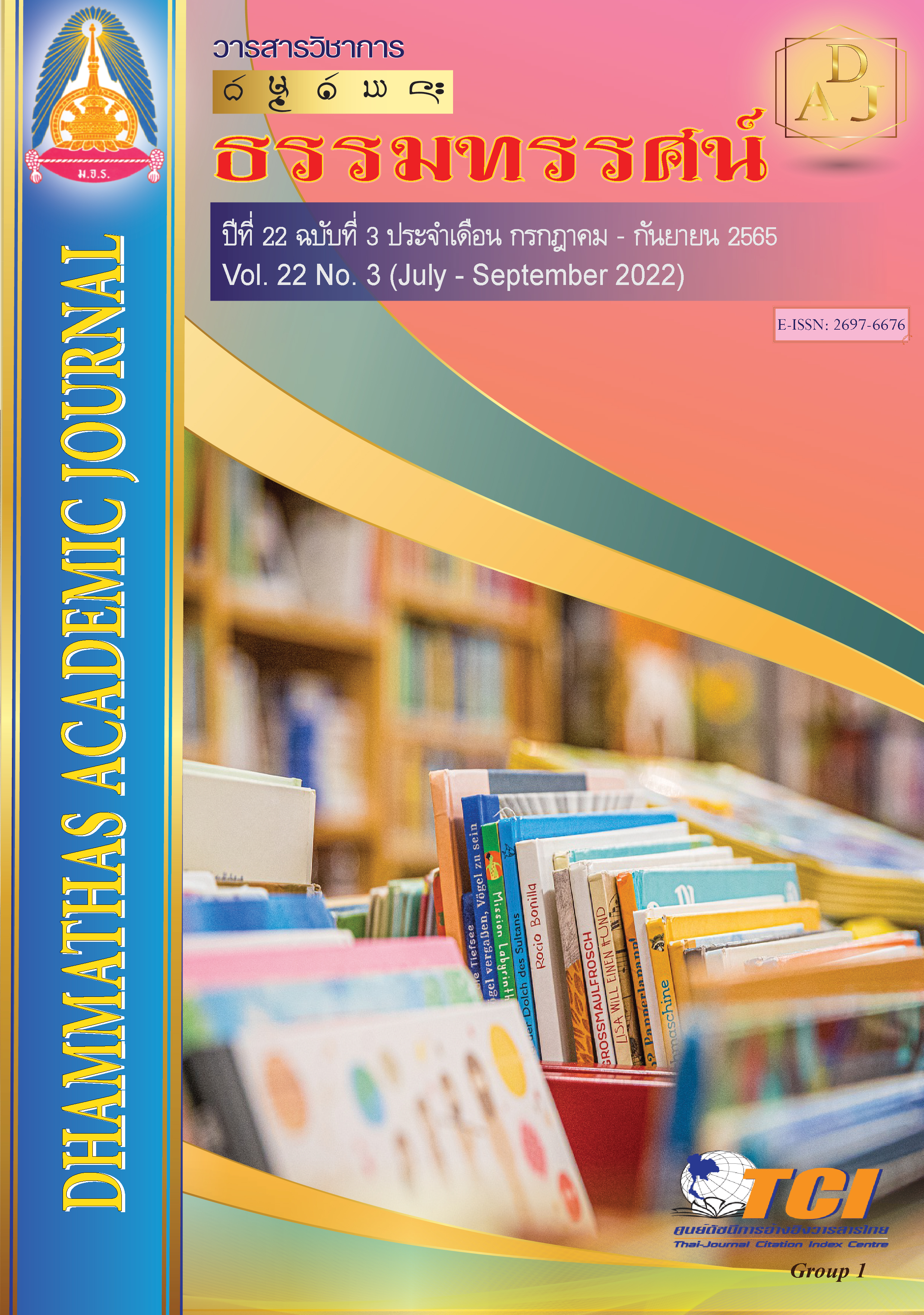Approaches to Enhancing Social Innovation in Small Secondary School
Main Article Content
Abstract
The objectives of this research were: 1) study the factors affecting social innovation in small secondary schools, 2) examine the consistency of A Structure Equation Model of Factors Affecting Social Innovation in Small Secondary Schools. Direct, indirect, and total influence, 3) study the approaches to enhancing Social Innovation in Small Secondary Schools. The research has been mixed method approach. Research methodology starting from Quantitative research 20 as much as the sample from the hypothetical model was used. Therefore, the sample was 240 small secondary schools. The informants for each school were administrators and teachers. A total of 480 respondents were included by multistage randomization. The instrument used was a questionnaire with Index of Consistency (IOC) is between 0.67-1.00 reliability value of 0.96 (Cronbach's Alpha Coefficient), a semi-structured interview. And an in-depth interview Data were analyzed using the Mplus statistical program, descriptive statistics, and reference statistics. Followed by qualitative research using a sample of 3 small secondary schools with outstanding social innovations by selective selection. Key informants consisted of administrators, teachers, and school committees. Data were collected by studying school information and interviewing informants. Data collection tools are document study form Record form and in-depth interview form Analyze the data by content analysis.
The results showed that:
1. The Confirmatory Factors of Social Innovation in Small Secondary Schools by the research showed a goodness-of-fit with statistical data as follows: x2 = 112.852, Df = 91, P-Value = 0.0601, RMSEA = 0.014, SRMR = 0.014, CFI = 0.999, TLI = 0.998.
2. Approaches to enhancing Social Innovation in Small Secondary Schools found that: Promotion of educational institutions to have concrete products that are innovative. Promote operations in accordance with the needs of society Use the school as a base to drive innovation to society. And promoting educational institutions to use community areas as a base to improve the quality of education of students. The results of the assessment of accuracy, suitability, feasibility, and usefulness. Overall, it's at the highest level.
Article Details

This work is licensed under a Creative Commons Attribution-NonCommercial-NoDerivatives 4.0 International License.
เพื่อให้เป็นไปตามกฎหมายลิขสิทธิ์ ผู้นิพนธ์ทุกท่านต้องลงลายมือชื่อในแบบฟอร์มใบมอบลิขสิทธิ์บทความ ให้แก่วารสารฯ พร้อมกับบทความต้นฉบับที่ได้แก้ไขครั้งสุดท้าย นอกจากนี้ ผู้นิพนธ์ทุกท่านต้องยืนยันว่าบทความ ต้นฉบับที่ส่งมาตีพิมพ์นั้น ได้ส่งมาตีพิมพ์เฉพาะในวารสาร วิชาการธรรม ทรรศน์ เพียงแห่งเดียวเท่านั้น หากมีการใช้ ภาพหรือตารางของผู้นิพนธ์อื่นที่ปรากฏในสิ่งตีพิมพ์อื่นมาแล้ว ผู้นิพนธ์ต้องขออนุญาตเจ้าของลิขสิทธิ์ก่อน พร้อมทั้ง แสดงหนังสือที่ได้รับการยินยอมต่อบรรณาธิการ ก่อนที่บทความจะได้รับการตีพิมพ์References
กระทรวงการพัฒนาสังคมและความมั่นคงของมนุษย์. (2563). พัฒนาศักยภาพบุคลากรคนรุ่นใหม่ พร้อมนำนวัตกรรมทางสังคมยกระดับคุณภาพชีวิตกลุ่มเป้าหมาย. เข้าถึงได้จาก https://gnews.apps.go.th/news?news=66092
คณะกรรมการพัฒนาการเศรษฐกิจและสังคมแห่งชาติ. (2562). ยุทธศาสตร์ชาติ พ.ศ. 2561-2580. (พิมพ์ครั้งที่ 2). กรุงเทพฯ: สำนักงานเลขานุการของคณะกรรมการยุทธศาสตร์ชาติ.
คีระคิน คำหนองไผ่. (2560). นวัตกรรมสร้างสรรค์ทางสังคมของโรงเรียนขนาดเล็ก สังกัดสำนักงานเขตพื้นที่การศึกษาประถมศึกษาขอนแก่น เขต 5: กรณีศึกษา. วารสารวิทยบริการ มหาวิทยาลัยสงขลานครินทร์, 28(2), 1-9.
ธนภัทร จันทร์เจริญ. (2562). การจัดการเรียนรู้สู่การศึกษาไทย 4.0. วารสารบัณฑิตศึกษา มหาวิทยาลัยราชภัฏวไลยอลงกรณ์, 13(3), 216-229.
ธนากร ศรีวิพัฒน์. (2561). นวัตกรรมสร้างสรรค์สังคมสำหรับโรงเรียนขนาดเล็ก: การศึกษาเพื่อสร้างทฤษฎีฐานราก. (วิทยานิพนธ์ปรัชญาดุษฎีบัณฑิต). ขอนแก่น: มหาวิทยาลัยขอนแก่น.
ประกฤติยา ทักษิโณ. (2559). เอกสารประกอบการอบรมเรื่อง การวิเคราะห์ข้อมูลด้วย LISREL และ MPLUS: ความรู้พื้นฐานก่อนการวิเคราะห์. ขอนแก่น: มหาวิทยาลัยขอนแก่น
ประเวศ วะสี. (2556). นวัตกรรมทางสังคมสร้างอนาคต. เข้าถึงได้จาก http://www.thaihealth.or.th/Content/16424-นวัตกรรมทางสังคมสร้างอนาคต.html
สำนักงานนวัตกรรมแห่งชาติ. (2562). Social Innovation. เข้าถึงได้จาก https://social.nia.or.th/index.php/2019/03/19/event066/
สำนักงานเลขาธิการสภาการศึกษา. (2560). แผนการศึกษาแห่งชาติ พ.ศ.2560-2579. กรุงเทพฯ: พริกหวานกราฟฟิค.
สุวิทย์ ยอดสละ. (2556). การพัฒนาภาวะผู้นำเชิงวิสัยทัศน์ของผู้บริหารโรงเรียนประถมศึกษา สังกัดสำนักงานคณะกรรมการการศึกษาขั้นพื้นฐาน. (วิทยานิพนธ์ศึกษาศาสตรดุษฎีบัณฑิต). มหาสารคาม: มหาวิทยาลัยมหาสารคาม.
สุวิมล ติรกานันท์. (2553). การวิเคราะห์ตัวแปรพหุในงานวิจัยทางสังคมศาสตร์. กรุงเทพฯ: จุฬาลงกรณ์มหาวิทยาลัย.
เสาวนี สิริสุขศิลป์. (2564). ภาวะผู้นำทางการนิเทศการศึกษา. (พิมพ์ครั้งที่ 2). ขอนแก่น: มหาวิทยาลัยขอนแก่น.
BEPA. (2020). Empowering people, driving change Social innovation in the European Union Bureau of European Policy Advisers, European Commission. Retrieved from http://ec.europa.eu/bepa/pdf/ publications_pdf/social_innovation.pdf
Cajaiba. (2017). Social innovation: Moving the field forward. A conceptual framework. Tech-nological Forecasting and Social Change, 82(1), 42-51.
Chesbrough, H. (2019). Open Innovation: Striving for Innovation Success in the 21st Century. Berkeley, CA: University of California at Berkeley.
Doer, J. (2018). Measure What Matters. New York: Penguin Random House.
Dunkerley, S., & Erturk, E. (2018). Understanding Gamification and Its Benefits. Journal of Applied Computing and Information Technology, 22(1).
European Commission. (2013). Guide to social. Regional and Urban Policy. Paris: European Commission.
Frank Moulaert. (2017). The International Handbook on Social Innovation. Cheltenham, UK: Edward Elgar Publishing Limited.
Gillwald. (2019). Understanding Digital Access and Use in the Global South. South Africa: Re-search ICT Africa.
Hair et al. (2010). Multivariate data analysis. (7th ed.). New Jersey: Prentice-Hall.
Howaldt & Schwarz. (2010). Social Innovation: Concepts, Research Fields and International Trends. Retrieved from www.internationalmonitoring.com/fileadmin/Downloads/Trendstudien/IMO%20Trendstudie_Howaldt_englisch_Final%20ds.pdfA
TEPSIE. (2014). Social innovation theory and research A Guide for researchers. Europe: Soap.
Zhou & He. (2018). Mitigation Pathways Compatible with 1.5°C in the Context of Sustainable Development. Retrieved from https://publications.pikpotsdam.de/pubman/faces/ViewItemFullPage.jsp?itemld=item_22900

